A Qualitative Methodology for Identifying Governance Challenges and Advancements in Positive Energy District Labs
Abstract
1. Introduction
- What are the current barriers to the implementation of PED-Labs?
- What are the drivers and incentive factors (‘unlocking factors’) that determine the “fertility of the soil” for PED-Lab initiatives?
- What processes and actors define the steps, power relationships, and subsidiarity in responsibilities and decisions within PED Lab initiatives?
2. Methods
2.1. Questionnaire Development and Data Collection
- Approve and refine a proposed list of items in each of the three proposed thematic areas, suggesting groupings and modifications where necessary.
- Rate each item using a Likert scale from 1 (low relevance) to 5 (high relevance).
- Participate in facilitated discussions to interpret questionnaire results collectively and identify key learnings.
2.1.1. Barriers
2.1.2. Drivers and Unlocking Factors
2.1.3. Stakeholders and Processes
2.1.4. Facilities
- The specific role of these facilities in the development of a PED Lab.
- Identification of tangible (hardware) and intangible (software) assets.
- Creation of a comprehensive list of facilities.
2.2. Qualitative Analysis
2.3. Findings
3. Results
3.1. Analysis of Barriers
- Policy: Energy plans, governance body visions, or political commitment.
- Administrative: Coordination, public participation, dissemination, ownership or authorization procedures.
- Legal and regulatory: Regulations, instability, building codes, incentives or privacy protection.
- Financial: Cost, financial support, access to capital, economic crisis or risks and uncertainty.
- Market: Split incentives, energy price distortion, or energy market actors.
- Environmental: Lack of information or negative effects on the natural environment.
- Technical: Tested solutions, technical commitments, qualified personnel, computational scalability, grid instability or accurate urban models.
- Social: Inertia, interest, acceptance, engagement, rebound effect, attitudes, exclusion or lack of trust.
- Information and awareness: Insufficient information, awareness, perceptions or information asymmetry.
3.2. Analysis of Drivers and Unlocking Factors
- Drivers: Climate change, urbanization trends, urban redevelopment, economic growth, market attractiveness, environmental quality, or energy autonomy.
- Unlocking factors: Technological improvements, innovative solutions, prefabricated packages, energy communities, prosumers, storage systems, decreasing cost, benefits, awareness, engagement, social acceptance, policy frameworks, funding, or multidisciplinary approaches.
3.3. Analysis of Stakeholders and Process Mapping
- Vision phase: The participation of universities and the R&D sector is determinant, along with that of the government and planners. Consulting with citizens is also a high priority.
- Decision phase: The government is the main actor, supported by citizens.
- Plan phase: In this phase, planners manage the process with support from the government, assisted by industry, universities, and developers.
- Do phase: Industry and developers are the primary actors operating within a framework promoted by the government. The role of financial institutions as investors also becomes prominent.
- Check/Act phase: All stakeholders must be involved in this phase in various capacities.
- Upscale/Replicate phase: This phase is linked to the ‘do phase’ and features a similar distribution of roles. Notably, the lack of citizen involvement in this phase is surprising.
3.4. Facilities Classification
3.5. SWOT Analysis
4. Discussion and Conclusions
5. Recommendations and Limitations
Author Contributions
Funding
Institutional Review Board Statement
Informed Consent Statement
Data Availability Statement
Acknowledgments
Conflicts of Interest
References
- Van der Heijden, J. When opportunity backfires: Exploring the implementation of urban climate governance alternatives in three major US cities. Policy Soc. 2021, 40, 116–135. [Google Scholar] [CrossRef]
- Derkenbaeva, E.; Halleck Vega, S.; Hofstede, G.J.; Van Leeuwen, E. Positive energy districts: Mainstreaming energy transition in urban areas. Renew. Sustain. Energy Rev. 2022, 153, 11782. [Google Scholar] [CrossRef]
- Sassenou, L.N.; Olivieri, L.; Olivieri, F. Challenges for positive energy districts deployment: A systematic review. Renew. Sustain. Energy Rev. 2024, 191, 114152. [Google Scholar] [CrossRef]
- Turci, G.; Civiero, P.; Aparisi-Cerdá, I.; Marotta, I.; Massa, G. Transition Approaches towards Positive Energy Districts: A Systematic Review. Buildings 2024, 14, 3039. [Google Scholar] [CrossRef]
- Doci, G.; Dorst, H.; Hillen, S.; Tjokrodikromo, T. Urban transition governance in practice: Exploring how European cities govern local transitions to achieve climate neutrality. Front. Sustain. Cities 2025, 7, 1559356. [Google Scholar] [CrossRef]
- Yadav, A.; Anwer, N.; Mahapatra, K.; Shrivastava, M.K.; Khatiwada, D. Analyzing the Role of Polycentric Governance in Institutional Innovations: Insights from Urban Climate Governance in India. Sustainability 2024, 16, 10736. [Google Scholar] [CrossRef]
- Voytenko, Y.; McCormick, K.; Evans, J.; Schliwa, G. Urban Living Labs for Sustainability and Low Carbon Cities in Europe: Towards a Research Agenda. J. Clean. Prod. 2016, 123, 45–54. [Google Scholar] [CrossRef]
- Afacan, Y. Impacts of urban living lab (ULL) on learning to design inclusive, sustainable, and climate-resilient urban environments. Land Use Policy 2023, 124, 106443. [Google Scholar] [CrossRef]
- Voorwinden, A.; Van Bueren, E.; Verhoef, L. Experimenting with collaboration in the Smart City: Legal and governance structures of Urban Living Labs. Gov. Inf. Q. 2023, 40, 101875. [Google Scholar] [CrossRef]
- Bechtel, J.; Kock, A. The relevance of urban agglomeration micro-foundations for the emergence of innovation in living labs: A qualitative field study. J. Clean. Prod. 2023, 427, 139280. [Google Scholar] [CrossRef]
- Mukama, M.; Kaviti Musango, J.; Smit, S.; Ceschin, F.; Petrulaityte, A. Development of living labs to support gendered energy technology innovation in poor urban environments. Technol. Soc. 2022, 68, 101850. [Google Scholar] [CrossRef]
- Aernouts, N.; Maranghi, E.; Ryckewaert, M. (Eds.) Towards a Definition of Socially-Oriented LivingLabs, 1st ed.; SoHoLab: Brussels, Belgium, 2020. [Google Scholar]
- Mbatha, S.P.; Musango, J.K. A Systematic Review on the Application of the Living Lab Concept and Role of Stakeholders in the Energy Sector. Sustainability 2022, 14, 14009. [Google Scholar] [CrossRef]
- Van Waes, A.; Nikolaeva, A.; Raven, R. Challenges and dilemmas in strategic urban experimentation: An analysis of four cycling innovation living labs. Technol. Forecast. Soc. Change 2021, 172, 121004. [Google Scholar] [CrossRef]
- Martin, E.; Kodukula, S.; Rony, Y.I.; Manala, B.; Rybski, D.; Lah, O. Urban Living Labs as Tools for Just Transition: Adapting the Living Lab Approach into the Development Cooperation Context, 1st ed.; Wuppertal Institute for Climate, Environment and Energy: Berlin, Germany, 2023. [Google Scholar]
- Urban Living Lab Center. Available online: https://www.living-lab.center/ (accessed on 1 July 2025).
- Kobashi, T.; Jittrapirom, P.; Yoshida, T.; Hirano, Y.; Yamagata, Y. SolarEV City concept: Building the next urban power and mobility systems. Environ. Res. Lett. 2021, 16, 024042. [Google Scholar] [CrossRef]
- Kobashi, T.; Choi, Y.; Hirano, Y.; Yamagata, Y.; Say, K. Rapid rise of decarbonization potentials of photovoltaics plus electric vehicles in residential houses over commercial districts. Appl. Energy 2022, 306, 118142. [Google Scholar] [CrossRef]
- Taipei Smart City Living Lab. Available online: https://we-gov.org/catalog/?mod=document&uid=778 (accessed on 1 July 2025).
- Choo, M.; Choi, Y.W.; Yoon, H.; Bae, S.B.; Yoon, D.K. Citizen Engagement in Smart City Planning: The Case of Living Labs in South Korea. Urban Plan. 2022, 8, 32–43. [Google Scholar] [CrossRef]
- Park, J.; Fujii, S. Living Lab Participants’ Knowledge Change about Inclusive Smart Cities: An Urban Living Lab in Seongdaegol, Seoul, South Korea. Smart Cities 2022, 5, 1376–1388. [Google Scholar] [CrossRef]
- Yu, C.; Yu, J.; Gao, D. Smart Cities and Greener Futures: Evidence from a Quasi-Natural Experiment in China’s Smart City Construction. Sustainability 2024, 16, 929. [Google Scholar] [CrossRef]
- Sibbitt, B.; McClenahan, D.; Djebbar, R.; Paget, K. Drake Landing Solar Community: Groundbreaking Solar. ASHRAE High Perform. Build. 2015, 8, 36. [Google Scholar]
- Shafiee Roudbari, E.; Kantor, I.; Menon, R.P.; Eicker, U. Optimization-based decision support for designing industrial symbiosis district energy systems under uncertainty. Appl. Energy 2024, 367, 123418. [Google Scholar] [CrossRef]
- Shafiee Roudbari, E.; Menon, R.P.; Kantor, I.; Eicker, U. Toward Positive Energy Districts by Urban–Industrial Energy Exchange. Designs 2023, 7, 73. [Google Scholar] [CrossRef]
- Haase, M.; Eicker, U.; Hachem-Vermette, C.; Kayo, G.; Rehman, H. Lessons learned from analyzing PED case studies. In Proceedings of the 12th International IEECB&SC’24 and European ESCO Conference 2024 “Improving Energy Efficiency in Commercial Buildings and Smart Communities”, Frankfurt, Germany, 6–7 March 2024. [Google Scholar]
- Laboratorio Para La Ciudad (LabCDMX), Mexico City. Available online: https://latinno.net/es/case/13232/ (accessed on 1 July 2025).
- Laboratorio de Gobierno de Chile. Available online: https://www.lab.gob.cl/ (accessed on 1 July 2025).
- Arquitectura Expandida (APX). Available online: https://arquitecturaexpandida.org/ (accessed on 1 July 2025).
- Castro, A.; Ponce de León, A.; Cantera, A.L.; Olofsson, V.; Reina-Rozo, J.D. Energy sovereignty storytelling: Art practices, community-led transitions, and territorial futures in Latin America. Tapuya Lat. Am. Sci. Technol. Soc. 2024, 7, 2309046. [Google Scholar] [CrossRef]
- Montero, S.; Whitney, R.; Peñaranda, I. Experimental Urban Planning: Tensions Behind the Proliferation of Urban Laboratories in Latin America. Plan. Theory Pract. 2023, 24, 473–488. [Google Scholar] [CrossRef]
- CSIRO’s Living Lab. Available online: https://www.csiro.au/en/research/environmental-impacts/sustainability/Urban-Living-Lab (accessed on 1 July 2025).
- Monash University Net Zero Precincts Living Lab. Available online: https://www.monash.edu/msdi/initiatives/project-pages/net-zero-precincts/living-lab (accessed on 1 July 2025).
- Lot Fourteen Innovation Hub. Available online: https://lotfourteen.com.au/projects/innovation-hub/ (accessed on 1 July 2025).
- Tahir, F.; Dwyer, S.; Kelly, S. Emergent opportunities and barriers on the feasibility of microgrids: Qualitative findings from an Australian funding program. Energy Res. Soc. Sci. 2024, 109, 103423. [Google Scholar] [CrossRef]
- Hamdan, H.A.M.; de Boer, L.; Andersen, P.H. The architecture of procurement in sustainable and zero-emission neighborhood projects—Strategic challenges and new realities. Environ. Syst. Decis. 2023, 43, 472–488. [Google Scholar] [CrossRef]
- Ekdi, F.P.; Kelly, N.; McElroy, L.B.; McQuillan, J.; Sharpe, T.; Statt, R. Zero Carbon Neighbourhoods Creating Non-Complex Information from Complex Data. In Proceedings of the 4th IBPSA-Scotland’s Biennial uSIM Conference “Shaping Net Zero Policies with Building Simulation”, Edinburgh, UK, 25 November 2024. [Google Scholar]
- Komninos, N. Net Zero Energy Districts: Connected Intelligence for Carbon-Neutral Cities. Land 2022, 11, 210. [Google Scholar] [CrossRef]
- Cardoso, J.; Leal, V.; Azevedo, I.; Silva, M.C. Designing carbon neutral, net-zero, nearly-zero and positive energy districts or neighbourhoods: Current approaches and solutions. Adv. Build. Energy Res. 2024, 18, 602–640. [Google Scholar] [CrossRef]
- Brozovsky, J.; Gustavsen, A.; Gaitani, N. Zero emission neighbourhoods and positive energy districts—A state-of-the-art re-view. Sustain. Cities Soc. 2021, 72, 103013. [Google Scholar] [CrossRef]
- JPI Urban Europe/SET-Plan Action no 3.2 Implementation Plan. Europe to Become a Global Role Model in Integrated, Innovative Solutions for the Planning, Deployment, and Replication of Positive Energy Districts. 2018. Available online: https://jpi-urbaneurope.eu/wp-content/uploads/2021/10/setplan_smartcities_implementationplan-2.pdf (accessed on 19 September 2024).
- JPI Urban Europe/SET Plan Action 3.2. White Paper on PED Reference Framework for Positive Energy Districts and Neighbourhoods. 2020. Available online: https://jpi-urbaneurope.eu/wp-content/uploads/2020/04/White-Paper-PED-Framework-Definition-2020323-final.pdf (accessed on 19 September 2024).
- Soutullo, S.; Aelenei, L.; Nielsen, P.S.; Ferrer, J.A.; Gonçalves, H. Testing Platforms as Drivers for Positive-Energy Living Laboratories. Energies 2020, 13, 5621. [Google Scholar] [CrossRef]
- Kalms, A.; Cornago, I.; Ezquer, M.; Diaz de Garayo, S.; Arias, A.; Torres, L.; San Emeterio, D.; Irulegi, O.; Bouchotrouch, F.; De Groote, M. “oPEN Lab” project as an underpin innovation for Positive Energy District solutions in Pamplona. J. Phys. Conf. Ser. 2023, 2600, 082029. [Google Scholar] [CrossRef]
- Utilizing Digital Twins for Urban Planning: An Integrated Approach to Sustainable and Smart City Development. 2024. Available online: https://expedite-project.eu/wp-content/uploads/2025/01/65210132-SWE-WP2-XX-T-X-0001_UrbanPlanningAndDigitalTwins.pdf (accessed on 1 July 2025).
- Boguslawski, P. Digital Twin for Positive Energy Districts (DiGiTwins4PED). Spectrum 2024, 17, 12–14. [Google Scholar]
- Lindholm, O.; Rehman, H.u.; Reda, F. Positioning Positive Energy Districts in European Cities. Buildings 2021, 11, 19. [Google Scholar] [CrossRef]
- Action Cost CA19126. Positive Energy Districts European Network (PED-EU-NET). Available online: https://www.cost.eu/actions/CA19126/ (accessed on 19 September 2024).
- Sinfonia European Project. Available online: http://www.sinfonia-smartcities.eu/ (accessed on 1 July 2025).
- Cities4PEDs European Project. Available online: https://energy-cities.eu/project/cities4peds/ (accessed on 1 July 2025).
- CONCERTO European Commission Initiative Within the European Research Framework Programme. Available online: https://www.concertoplus.eu (accessed on 1 July 2025).
- Driving Urban Transitions to a Sustainable Future. Available online: https://dutpartnership.eu/ (accessed on 1 July 2025).
- PED Database. Available online: https://pedeu.net/map/?ped_type=&phase=&project= (accessed on 1 July 2025).
- JPI Urban Europe. Available online: https://jpi-urbaneurope.eu/ (accessed on 1 July 2025).
- IEA EBC Annex 83. Available online: https://annex83.iea-ebc.org/ (accessed on 1 July 2025).
- Vettorato, D.; Bukovszki, V.; Soutullo Castro, S.; Etminan, G.; Andreucci, M.B.; Pignatta, G.; Lima, R.; Ashrafian, T.; Semprini, G.; Sánchez, M.N.; et al. Review of Existing Urban Laboratories (Review Exiting Concept, Projects and Facilities that are Relevant to PED Labs). Online Deliverable 3.1 Cost Action CA19126. Available online: https://pedeu.net/wp-content/uploads/2022/10/D3.1_Review_existing-urban-laboratories.pdf (accessed on 1 July 2025).
- Mosannenzadeh, F.; Di Nucci, M.R.; Vettorato, D. Identifying and Prioritizing Barriers to Implementation of Smart Energy City Projects in Europe: An Empirical Approach. Energy Policy 2017, 105, 191–201. [Google Scholar] [CrossRef]
- Razmjoo, A.; Østergaard, P.A.; Denaï, M.; Nezhad, M.M.; Mirjalili, S. Effective Policies to Overcome Barriers in the Development of Smart Cities. Energy Res. Soc. Sci. 2021, 79, 102175. [Google Scholar] [CrossRef]
- Bukovszki, V.; Magyari, A.; Braun, M.K.; Párdi, K.; Reith, A. Energy Modelling as a Trigger for Energy Communities: A Joint Socio-Technical Perspective. Energies 2020, 13, 2274. [Google Scholar] [CrossRef]
- Yigitcanlar, T.; Kamruzzaman, M.; Buys, L.; Ioppolo, G.; Sabatini-Marques, J.; Moreira da Costa, E.; Yun, J.J. Understanding ‘smart cities’: Intertwining development drivers with desired outcomes in a multidimensional framework. Cities 2018, 81, 145–160. [Google Scholar] [CrossRef]
- Tan, S.Y.; Taeihagh, A. Smart City Governance in Developing Countries: A Systematic Literature Review. Sustainability 2020, 12, 899. [Google Scholar] [CrossRef]
- Quadros Aniche, L.; Edelenbos, J.; Gianoli, A.; Caruso, R.; DeLosRíos-White, M.I.; Pyl Wissink-Nercua, C.; Undabeitia, A.; Enseñado, E.M.; Gharbia, S. Contextualizing and generalizing drivers and barriers of urban living labs for climate resilience. Environ. Policy Gov. 2024, 34, 490–523. [Google Scholar] [CrossRef]
- Cheng, C.; Albert-Seifried, V.; Aelenei, L.; Vandevyvere, H.; Seco, O.; Sánchez, M.N.; Hukkalainen, M. A Systematic Approach Towards Mapping Stakeholders in Different Phases of PED Development—Extending the PED Toolbox. In Sustainability in Energy and Buildings. Smart Innovation, Systems and Technologies, 1st ed.; Littlewood, J.R., Howlett, R.J., Jain, L.C., Eds.; Springer: Singapore, 2021; Volume 263, pp. 447–463. [Google Scholar]
- Hearn, A.X. Positive energy district stakeholder perceptions and measures for energy vulnerability mitigation. Appl. Energy 2022, 322, 119477. [Google Scholar] [CrossRef]
- Natanian, J.; Magyari, A.; Brunetti, A.; Reith, A.; Guarino, F.; Manapragada, N.; Cellura, S.; de Luca, F.; Naboni, E. Ten Questions on Tools and Methods for Positive Energy Districts. Build. Environ. 2024, 255, 111429. [Google Scholar] [CrossRef]
- Krangsås, S.G.; Steemers, K.; Konstantinou, T.; Soutullo, S.; Liu, M.; Giancola, E.; Prebreza, B.; Ashrafian, T.; Murauskaitė, L.; Maas, N. Positive Energy Districts: Identifying Challenges and Interdependencies. Sustainability 2021, 13, 10551. [Google Scholar] [CrossRef]
- Kozlowska, A.; Guarino, F.; Volpe, R.; Bisello, A.; Gabaldòn, A.; Rezaei, A.; Albert-Seifried, V.; Alpagut, B.; Vandevyvere, H.; Reda, F.; et al. Positive Energy Districts: Fundamentals, Assessment Methodologies, Modeling and Research Gaps. Energies 2024, 17, 4425. [Google Scholar] [CrossRef]
- BIPED Community. Visualised Steps and Guidance in PED Stakeholder Mapping & a Framework with Tools for Engaging PED Stakeholders. Available online: https://www.bi-ped.eu/ (accessed on 1 July 2025).
- Rankinen, J.A.; Lakkala, S.; Haapasalo, H.; Hirvonen-Kantola, S. Stakeholder Management in PED Projects: Challenges and Management Model. Int. J. Sustain. Energy Plan. Manag. 2022, 34, 91–106. [Google Scholar] [CrossRef]
- Bossi, S.; Gollner, C.; Theierling, S. Towards 100 Positive Energy Districts in Europe: Preliminary Data Analysis of 61 European Cases. Energies 2020, 13, 6083. [Google Scholar] [CrossRef]
- Larsson Kolessar, L.L. Deliverable 2.2 Holistic Stakeholder Model for early PEDs. 2022. Available online: https://sustainableinnovation.se/app/uploads/2022/05/PED-ID_D2.2_StakeholderEngagementProcess_v3_220415.pdf (accessed on 1 July 2025).
- PED-ID: Holistic Assessment and Innovative Stakeholder Involvement Process for Identification of Positive-Energy-Districts. Available online: https://jpi-urbaneurope.eu/wp-content/uploads/2021/06/PED_Pilot_Cal_FinalReportGeneralPublic_PED-ID.pdf (accessed on 1 July 2025).
- Soutullo, S.; Ferrer, J.A.; Seco, O.; López, H.; Sánchez, M.N.; Vitale, M.J.; Reyes, A.L.; Correa, E.N.; De Diego, L. Sustainable transformation in the Latin American and Caribbean districts through the implementation of a qualitative methodology. Challenges and key aspects to be addressed. J. Clean. Prod. 2024, 472, 143336. [Google Scholar] [CrossRef]

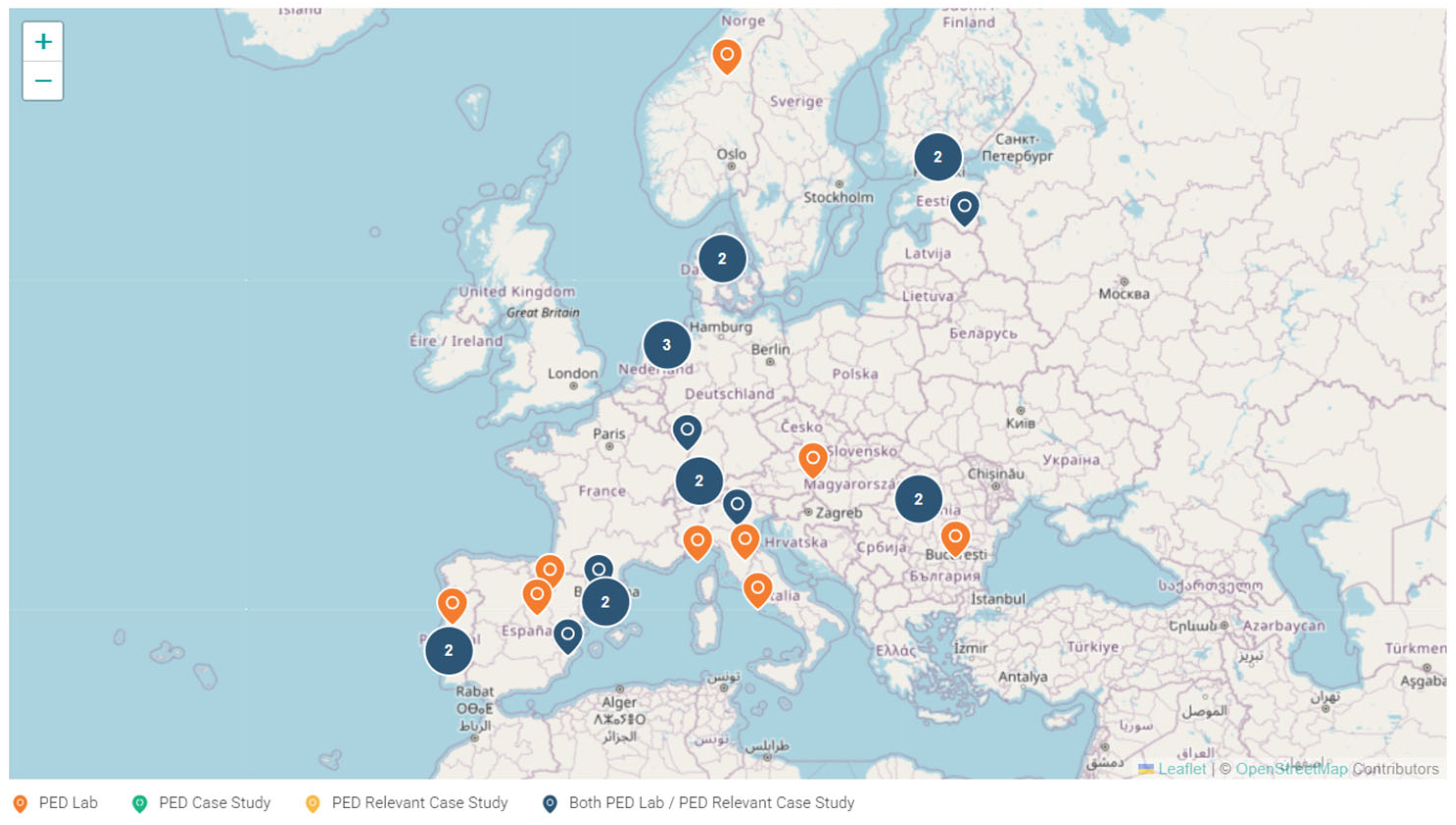
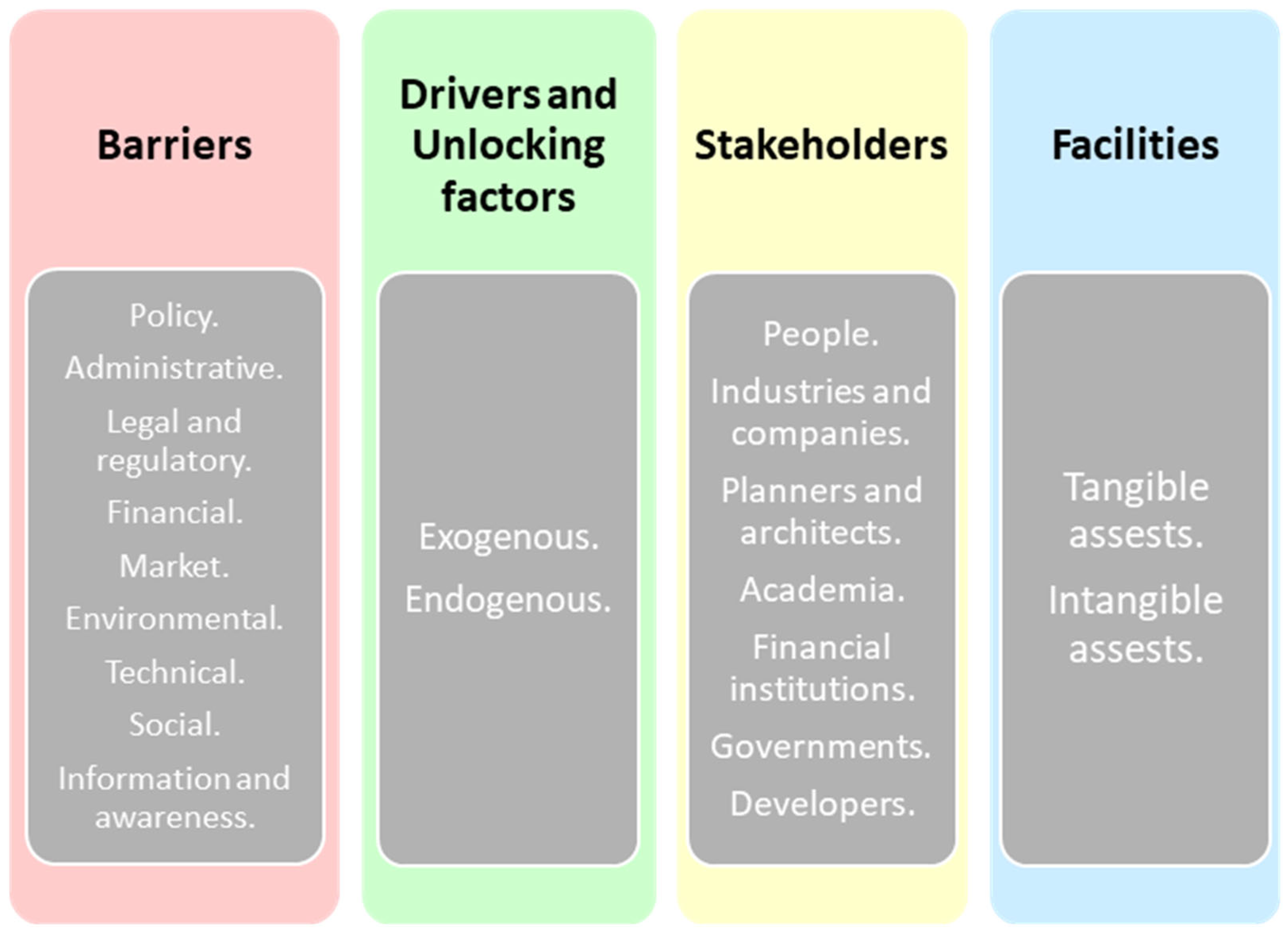
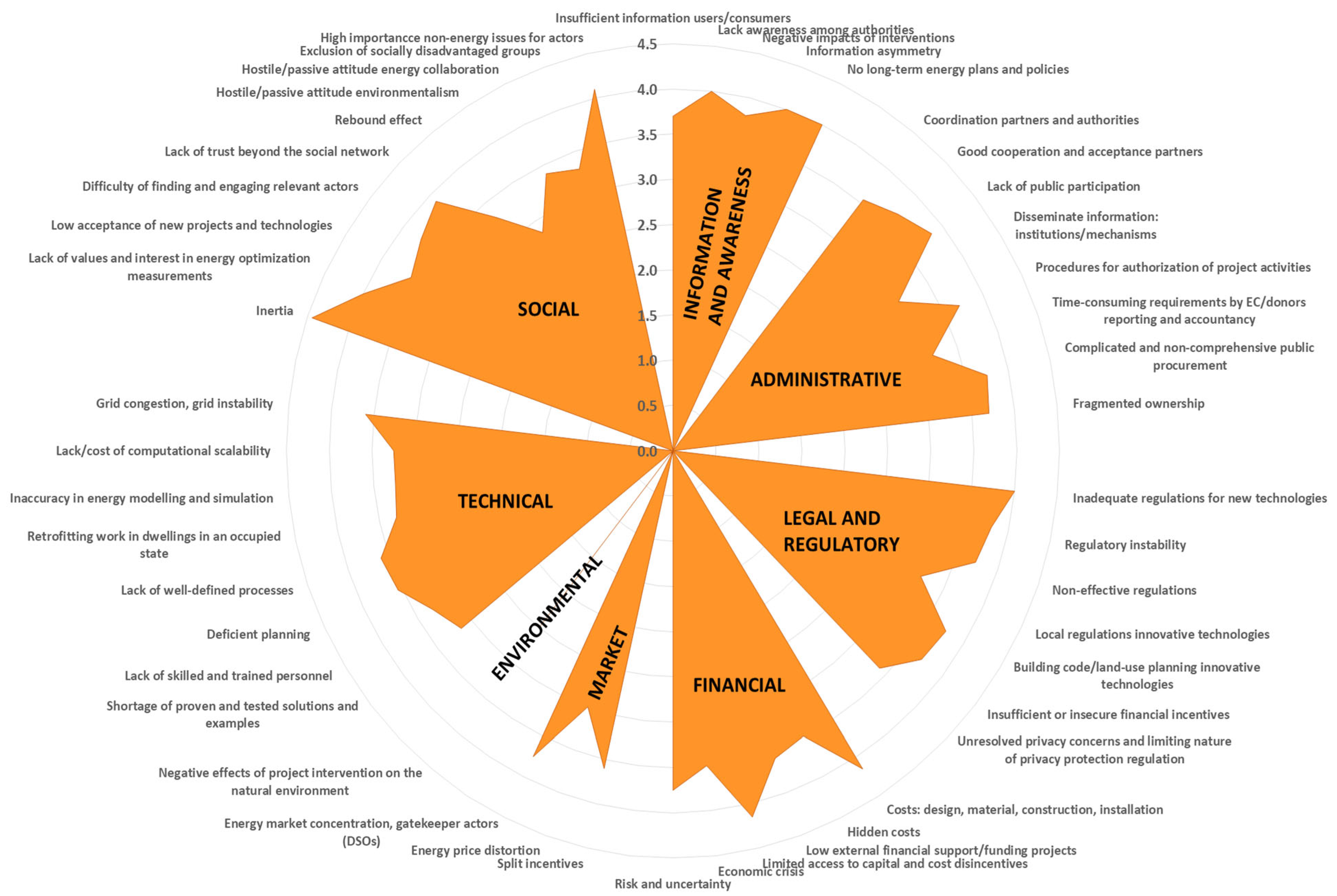

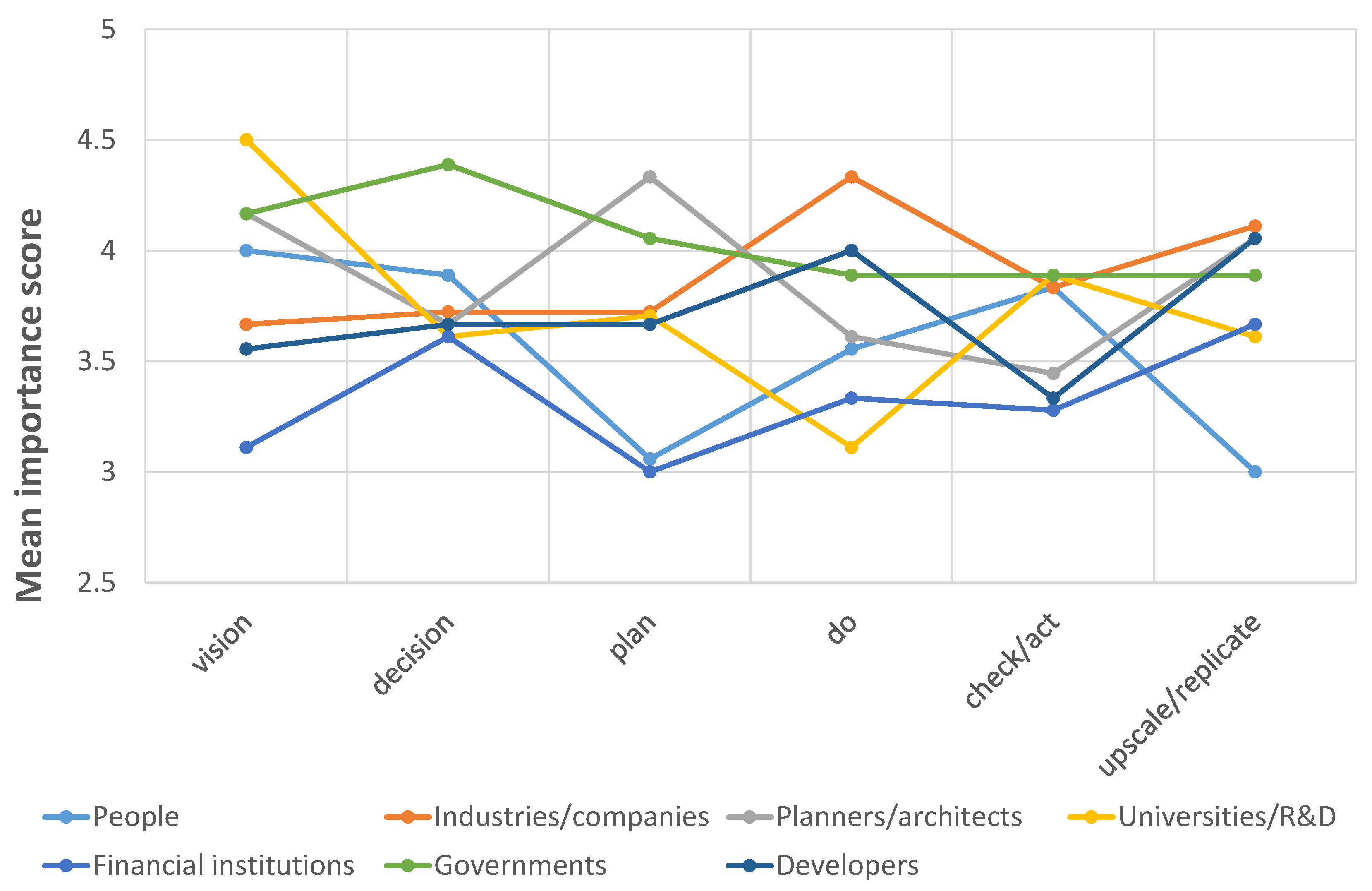
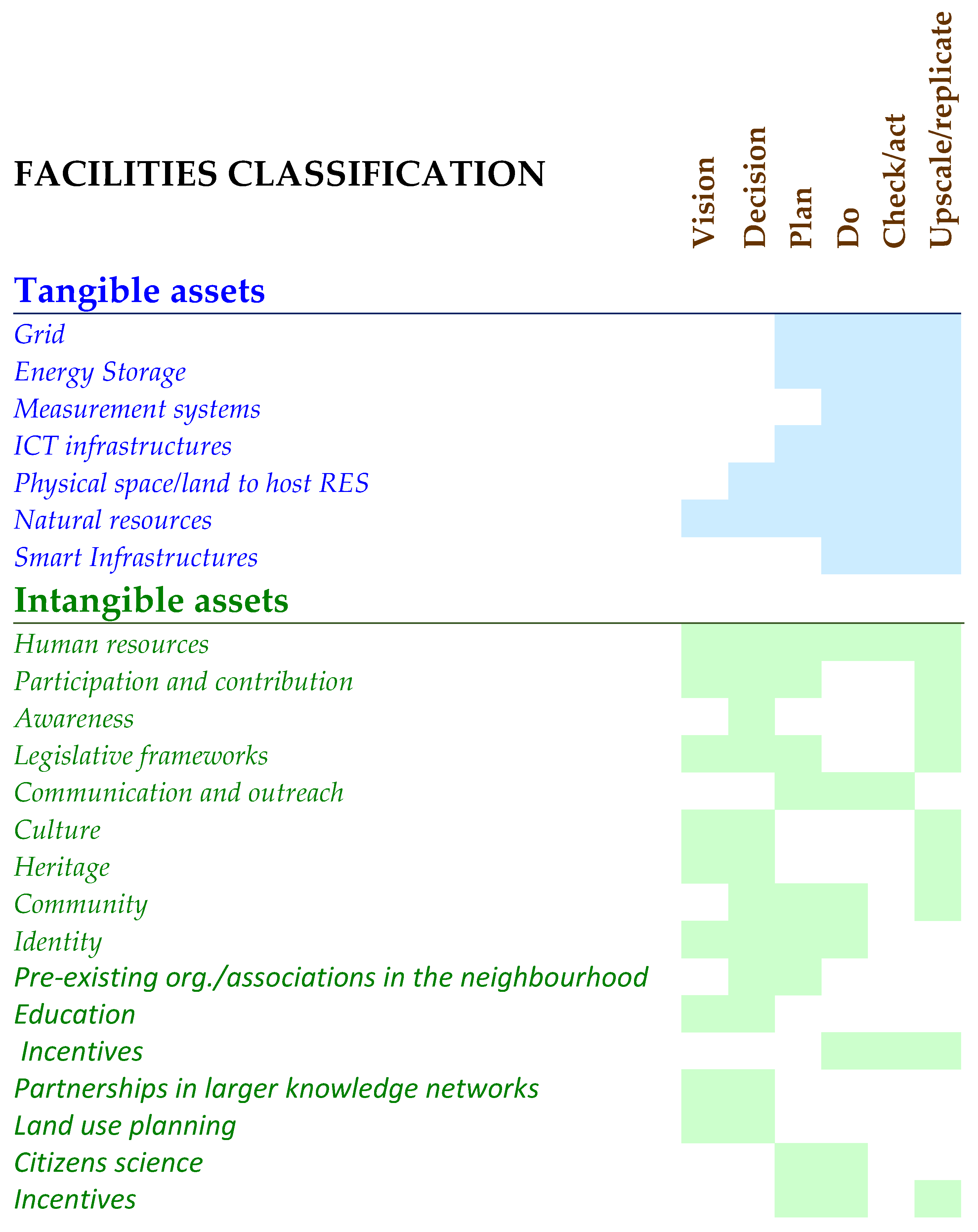
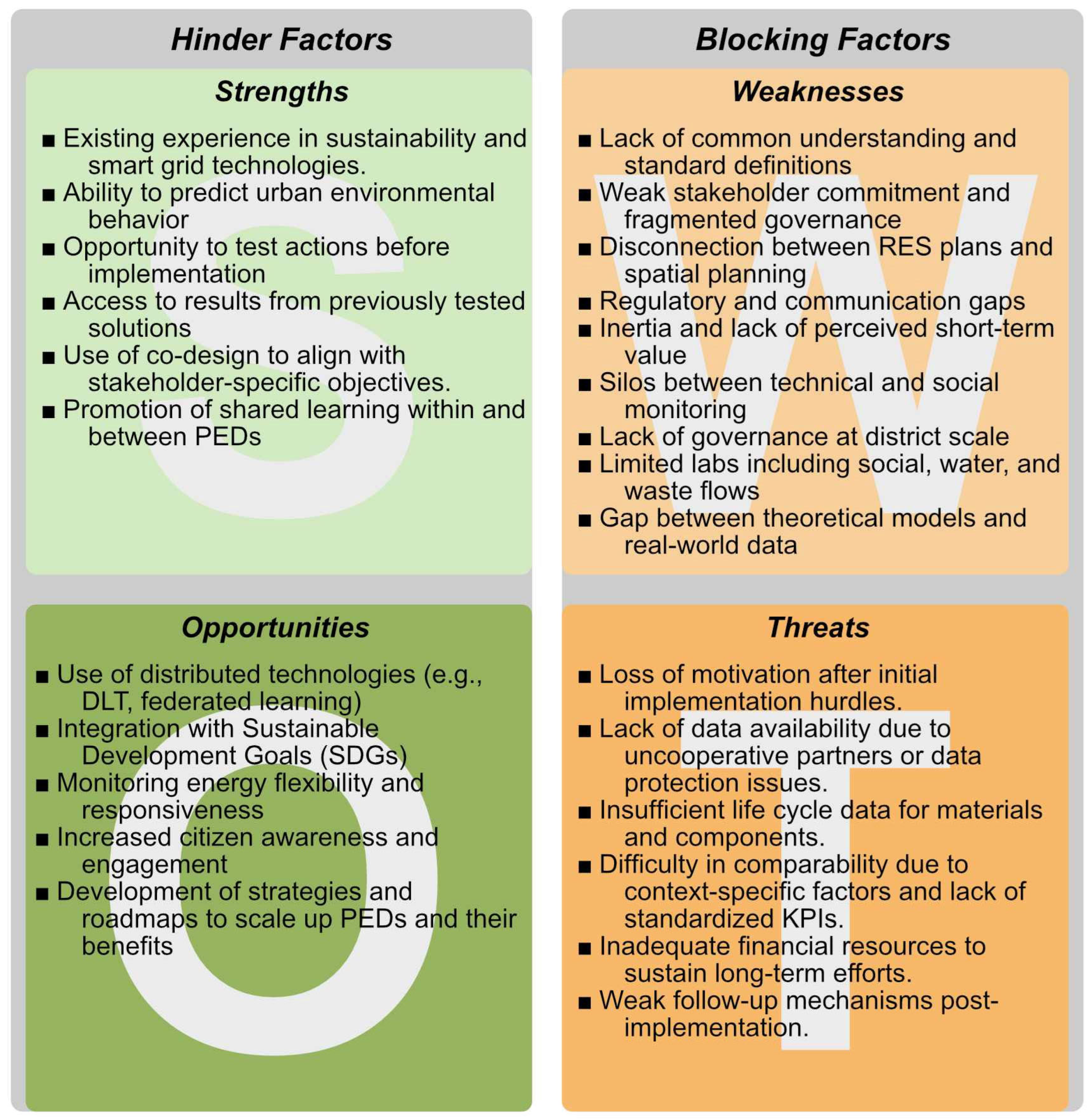
| Stakeholder Category | Stakeholder Type |
|---|---|
| Community | Residents, citizens, property owners, energy communities, and neighborhood organizations |
| Financial | Investors, banks, funding providers, and financial institutions |
| Industry | Technology providers, grid operators, energy providers, and private companies |
| Planning | Urban planners, architects, and consultants |
| Research | Universities, research institutions, and research-performing private companies |
| Policy | Local and national authorities, public administrations, and local and national governments |
| Developer | Real estate, asset, and portfolio developers and managers |
| Phase | Number | Characteristics |
|---|---|---|
| Planning | 12 | Many of the PED Labs are planned within the framework of European projects targeting energy goals, climate neutrality, or inequality reduction. They leverage public–private partnerships and require more tailored regulations, broader stakeholder involvement and dissemination, and the simplification of certain administrative procedures. |
| Implementation | 12 | Several have been developed within European projects aimed at increasing energy efficiency and sustainability while reducing vulnerabilities. They leverage reduced material and technology costs and greater short-term stakeholder engagement. They require simpler, better-coordinated administrative procedures, more robust medium and long-term plans, and well-developed economic models. |
| Completed | 1 | Rehabilitated suburban area in Trento (Stardust project), which leveraged existing financing and economic models to improve energy efficiency and sustainability. It requires ongoing funding and stakeholder involvement to ensure the proper maintenance of the facilities in the future. |
| In Operation | 5 | Real, virtual, and semi-virtual laboratories (some also developed within European projects) operate through various funding sources. Require effective coordination, greater stakeholder engagement, and sustained funding to operate with updated facilities. |
| Phase | Dominant Actor | Main Facilities Assets | Engagement Concept |
|---|---|---|---|
| Vision | Research | Intangible | Citizen science, co-discovery |
| Decision | Policy and community | Intangible | Participatory democracy |
| Plan | Planning | Tangible and Intangible | Participatory planning and design |
| Do | Industry | Tangible | Citizen science, field testing |
| Check/Act | Industry, policy, research | Tangible | Sense making, site policy, and design recommendations |
| Upscale/Replicate | Industry, policy, planners, developers | Tangible and Intangible | Strategizing, general policy, market rollout recommendations |
| Recommendation | Implementation Mechanism | Expected Effects |
|---|---|---|
| Prioritize stakeholder commitment and participation. | Develop tailored communication strategies for each stakeholder category, highlighting their specific value propositions | Balanced participation across stakeholder categories, embedding inclusion principles in PED Labs operations, and enhancing representativeness |
| Build coherent and inclusive governance at the district level, promoting citizen involvement in leadership wherever possible. | Design appropriate governance mechanisms through multi-stakeholder dialog. Identify and engage vulnerable and marginalized groups. Establish rules with PED Lab promoters to empower citizens. | More effective and impactful PED Labs, with inclusive governance and extended user-centered validation processes. |
| Focus on integrated, holistic district planning, incorporating other dimensions into the energy approach. | Establish a common planning tool at the district level as a PED Lab asset. Integrate energy dimension with mobility, services, zoning, and green infrastructure. Prioritize open source and open data systems to reduce barriers. | Consistent data collection, integration, and management. Holistic view of energy in district master planning. Open access to data and services. |
| Capitalize on favorable regulations through communication and action plans. | Map the existing regulatory landscape and promote strategies to activate supportive regulations via PED Lab governance. | Integration of the PED Lab into multilevel governance, accelerating the adoption of relevant energy and climate regulations. |
| Identify quick wins and short-term added value to motivate stakeholders. | Map project outputs and assets and identify those most suitable to deliver immediate value to stakeholders. Implement scaling-up actions on selected bundles. | Increased stakeholder engagement, reduced skepticism and disillusionment, and improved communication and dissemination through success stories. |
| Break down silos between technical, social, environmental, and political approaches | Provide tools for balanced dialog among stakeholders, introduce citizen science approaches and science-policy focus groups, and establish challenge-driven cross-disciplinary teams. | PED Labs are positioned as place-based open innovation platforms where diverse disciplines contribute to urban problem solving. |
| Leverage all available data providers, including citizen science, to bridge modeling with real-world applications. | Map data providers and develop value propositions to engage them in data sharing. Engage citizen science NGOs and pursue funding to increase high-quality citizen-sourced data generation. | Broader data sources, improved model validation, and enhanced citizens’ involvement and awareness. |
| Further develop Information and Communication Technologies (ICT) in laboratory facilities. | Expand district ICT infrastructure through targeted projects, partnerships with technology providers, and the activation of underutilized assets (e.g., smart meters, home automation) with smart software solutions. | Improved data collection processes, greater data volume and coverage, and expanded opportunities for experimentation in PEDs. |
| Define reliable business models to test different scenarios, combining technologies and innovations | Integrate systemic business modeling as a core component of PED Labs. Engage stakeholders to align diverse interests and desired impacts in business model design. | Increased private sector interest, fairness embedded in co-designed models with vulnerable groups representatives, and greater acceptance and scalability. |
| Integrate PED Labs into urban strategies for achieving the UN SDGs | Develop a tool linking PED Lab outcomes to UN SDGs targets, demonstrating the contribution of PED solutions when fully deployed. | Enhanced contribution of PED Labs to local SDG agendas, and greater community mobilization toward sustainability goals |
| Offer PED Labs as a platform to strengthen and scale PEDs | Design PED Labs as experimental open innovation, demonstrating how learning-by-testing reduces costs and improves acceptance and effectiveness. | Enhanced flexibility of PEDs through innovation and the establishment of continuous learning-by-testing cycles. |
| Manage the motivation cycle by design, including regular revamping actions and resource allocation | Incorporate regular motivation-boosting activities in PED Lab roadmaps and action plans, tailored for each category of stakeholder. Institutionalize stakeholder consultation about the motivation to stay engaged. Implement fair resource allocation mechanisms through inclusive governance, such as participatory budgeting. | Sustained interest and participation from diverse stakeholder groups, and fair resource allocation with greater benefits for citizens and underrepresented categories |
| Promote data sharing and prevent conflicts and a lack of cooperation by establishing clear rules and agreements | Co-design codes of conduct, engagement rules, and MoUs to establish the PED Lab as a trusted space and prevent conflicts over data sharing. | Smooth implementation of data sharing processes and mutually beneficial deals in data sharing among key providers. |
| Address sustainability from the early stages. | Integrate broad sustainability goals (social, economic, and ecological) into the PED Lab’s design, development roadmap, and KPIs. | Strengthened role of PEDs in sustainability agendas and multilevel action plans. |
| Develop climate change, energy efficiency, renewable, social, and economic measures based on proven experiments. | Establish science-policy dialogs at the local level and support them with experimental roadmaps in PED Labs. Conduct joint planning and reviews to maximize their policy relevance. | PEDs become infrastructures supporting policy-science interfaces, improving the quality of local policies through continuous data availability and validation feedback. |
Disclaimer/Publisher’s Note: The statements, opinions and data contained in all publications are solely those of the individual author(s) and contributor(s) and not of MDPI and/or the editor(s). MDPI and/or the editor(s) disclaim responsibility for any injury to people or property resulting from any ideas, methods, instructions or products referred to in the content. |
© 2025 by the authors. Licensee MDPI, Basel, Switzerland. This article is an open access article distributed under the terms and conditions of the Creative Commons Attribution (CC BY) license (https://creativecommons.org/licenses/by/4.0/).
Share and Cite
Soutullo, S.; Seco, O.; Sánchez, M.N.; Lima, R.; Montagnino, F.M.; Pignatta, G.; Etminan, G.; Bukovszki, V.; Ashrafian, T.; Andreucci, M.B.; et al. A Qualitative Methodology for Identifying Governance Challenges and Advancements in Positive Energy District Labs. Urban Sci. 2025, 9, 288. https://doi.org/10.3390/urbansci9080288
Soutullo S, Seco O, Sánchez MN, Lima R, Montagnino FM, Pignatta G, Etminan G, Bukovszki V, Ashrafian T, Andreucci MB, et al. A Qualitative Methodology for Identifying Governance Challenges and Advancements in Positive Energy District Labs. Urban Science. 2025; 9(8):288. https://doi.org/10.3390/urbansci9080288
Chicago/Turabian StyleSoutullo, Silvia, Oscar Seco, María Nuria Sánchez, Ricardo Lima, Fabio Maria Montagnino, Gloria Pignatta, Ghazal Etminan, Viktor Bukovszki, Touraj Ashrafian, Maria Beatrice Andreucci, and et al. 2025. "A Qualitative Methodology for Identifying Governance Challenges and Advancements in Positive Energy District Labs" Urban Science 9, no. 8: 288. https://doi.org/10.3390/urbansci9080288
APA StyleSoutullo, S., Seco, O., Sánchez, M. N., Lima, R., Montagnino, F. M., Pignatta, G., Etminan, G., Bukovszki, V., Ashrafian, T., Andreucci, M. B., & Vettorato, D. (2025). A Qualitative Methodology for Identifying Governance Challenges and Advancements in Positive Energy District Labs. Urban Science, 9(8), 288. https://doi.org/10.3390/urbansci9080288








